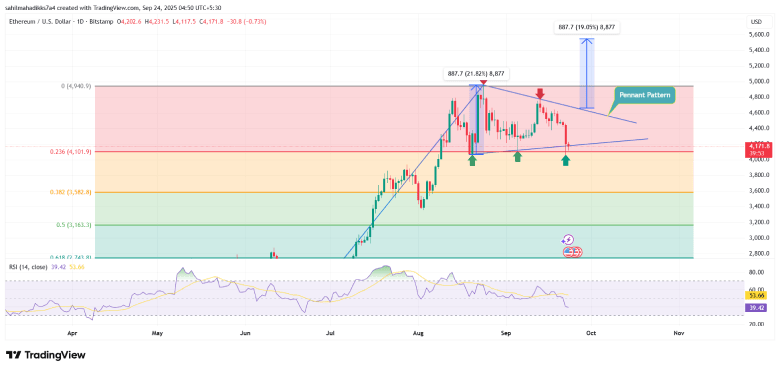- The Ethereum price is witnessing short-term consolidation amid the formation of a flag pattern.
- The SEC has approved NYSE Arca’s rule change, allowing Grayscale Ethereum ETFs to operate under new generic listing standards.
- SEC’s generic listing structure also ensures uniformity in products, making the introduction of new ETFs easier.
On Tuesday, September 23rd, the broader crypto market witnessed continued selling pressure as Bitcoin price dived below the $112,000 mark. Following this momentum, the second-largest crypto, Ethereum, initially hit an intraday low of $4,100 before reverting to $4,185. The buying pressure is observed at a key support of a bullish chart pattern, but the underlying reason could be the development in exchange-traded funds tied to the ETF. The recently approved Grayscale Ethereum ETFs from the U.S. Securities and Exchange Commission under the new generic listing standard bolster the potential of the Ethereum price.
SEC Approves Generic Listing for Grayscale Ethereum ETFs
The U.S. Securities and Exchange Commission has granted the mandate that the rule amendment in rule 8.201-E (Non-Generic) of the Grayscale Ethereum Trust ETF and Grayscale Ethereum Mini Trust ETF, first filed on September 19, 2025, can be changed to the rule 8.201-E (Generic). This change enables both ETFs to trade in accordance with the generic listing terms and eliminates the need for case-by-case approvals.
Through this change, Ethereum-based ETFs can now be listed under more standardized listing requirements, allowing for the easy launch of additional products. The new change will simplify market access, especially for institutional investors, who can now incorporate Ethereum exposure in regulated ETFs instead of handling actual token ownership.
Moreover, the Spot Ethereum ETF has seen an increase in trading activity since its launch. The market volume has now reached approximately 15% of all spot market volume, a significant increase compared to the about 3% of the market recorded in November 2024, just a few months after these funds were launched. This trend points out a growing interest among institutional and retail users towards controlled exposure to Ethereum.
The ease of operation and security of owning such ETFs also contribute to their popularity. Investors can access Ethereum without dealing with individual keys or custodial issues and have a more familiar regulated investment vehicle.
As the SEC approved the generic listing change, future Ethereum ETFs may have a faster approval process, potentially introducing more products to the market. The entry of additional funds and an increase in trading volumes are driving demand created by these regulated vehicles, which in turn supports the price of ETH.
Ethereum Price Holds Key Support For Reversal
Over the past six weeks, the price of Ethereum has traveled in a sideways trend, resonating within the two converging trendlines of a bull flag pattern. Theoretically, this consolidation follows a strong uptrend in price growth, allowing buyers to recoup their exhausted bullish momentum.
The price bounced at least twice from each trendline, accentuating how the pattern influenced ETH’s potential price trajectory. Amid the current market correction, the Ethereum price is again positioned at the bottom trendline of the triangle. The daily chart displays long-tail rejection candles at the dynamic support, indicating the presence of demand pressure.
A potential bullish surge from this support could drive an 8.8% jump and challenge the overhead trendline at $4,502. The altcoin holding above the trend-defining EMAs 100 and 200 accentuates that the broader trend is supportive of an upside breakout.
If buyers flip the overhead trendline into potential support, the price could leap to a new high of $5,500.

On the contrary, if the sellers force a breakdown below the pattern’s support trendline, the Ethereum price could enter a deeper correction.
Also Read: Tether Considers Massive Funding Round at $500B Valuation



